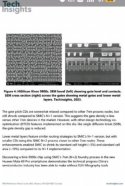Gate pitch栅间距比其他厂的7nm工艺更宽松。然而相比去年的smic n+1工艺依然有所微缩。这说明n+2的单管密度仍然弱于其他厂的7nm。
然而通过其他的设计-生产协同优化(DTCO)。例如单扩散隔断(SDB),弥补了单管密度上的差距(和去年n+1的报告1个说法,应该还是6track高密度库)
较低的金属层体现出和smic n+1类似的布线策略,但是更小的gate pitch使得n+2工艺更接近于其他厂的7nm节点。和去年相比,上面这些进步使得n+2节点的std cell的高度缩小5%,cell面积缩小了10%
k9000s上的最新工艺说明中国大陆的晶圆厂可以不依托EUV进军7nm节点
The gate patch CDs are somewhat relaxed compared to other 7nm process nodes, but still shrunk compared to SMICs N+1 version. This suggests the gate density is less versus other 7nm devices in the market. However, with other design-technology co-optimization (DTCO) features implemented on this die, like single diffusion break (SDB).the gate density gap is reduced.
Lower metal layers feature similar routing strategies to SMIC's N+1 version, but with smaller CDs bring this SMIC N+2 process closer to other 7nm nodes. These enhancerments enabled SMIC to shrink its standard cell height (-5%) and standard cell area (-10%) compared to its N+1 implementation.
Discovering a Kirin 9000s chip uting SMIC's 7nm (N+2) foundry process in the new Huawei Mate 60 Pro smartphone demonstrates the technical progress China's semiconductor industry has been able to make without EUV lithography tools.

然而通过其他的设计-生产协同优化(DTCO)。例如单扩散隔断(SDB),弥补了单管密度上的差距(和去年n+1的报告1个说法,应该还是6track高密度库)
较低的金属层体现出和smic n+1类似的布线策略,但是更小的gate pitch使得n+2工艺更接近于其他厂的7nm节点。和去年相比,上面这些进步使得n+2节点的std cell的高度缩小5%,cell面积缩小了10%
k9000s上的最新工艺说明中国大陆的晶圆厂可以不依托EUV进军7nm节点
The gate patch CDs are somewhat relaxed compared to other 7nm process nodes, but still shrunk compared to SMICs N+1 version. This suggests the gate density is less versus other 7nm devices in the market. However, with other design-technology co-optimization (DTCO) features implemented on this die, like single diffusion break (SDB).the gate density gap is reduced.
Lower metal layers feature similar routing strategies to SMIC's N+1 version, but with smaller CDs bring this SMIC N+2 process closer to other 7nm nodes. These enhancerments enabled SMIC to shrink its standard cell height (-5%) and standard cell area (-10%) compared to its N+1 implementation.
Discovering a Kirin 9000s chip uting SMIC's 7nm (N+2) foundry process in the new Huawei Mate 60 Pro smartphone demonstrates the technical progress China's semiconductor industry has been able to make without EUV lithography tools.

Last edited:
